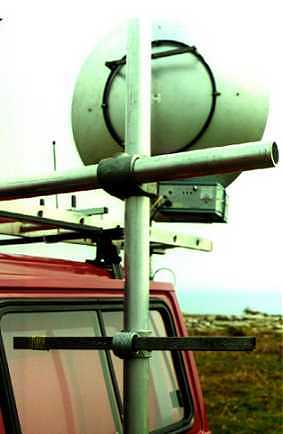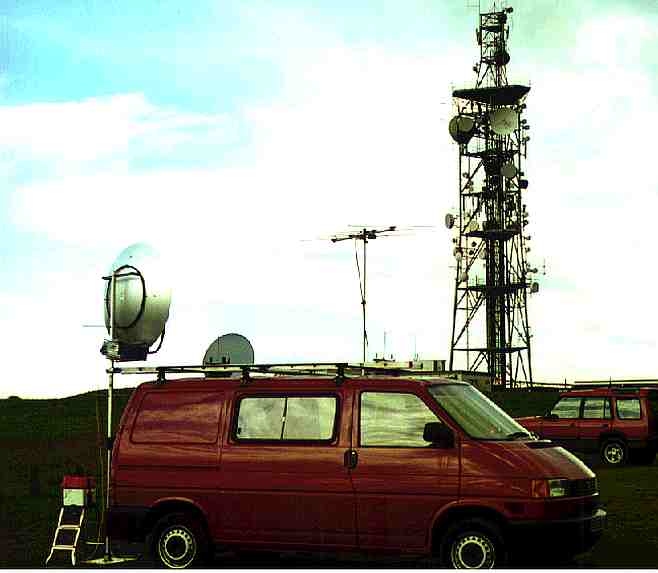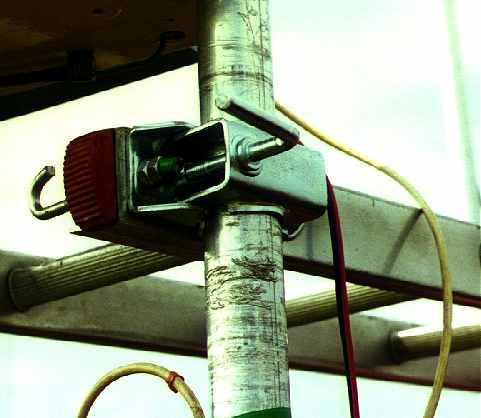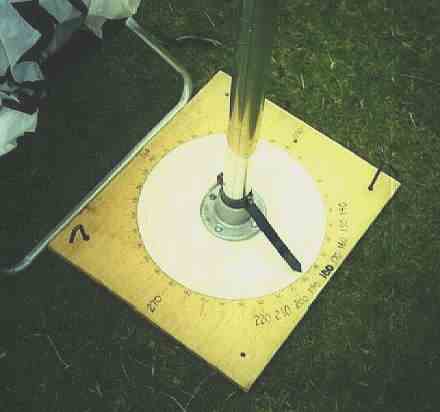|
G3PHO/P
MICROWAVE STATION
FOR
THE YEAR 2000
|
| Over the
past twenty years, I have operated from a VW Campervan during
the all-day microwave contests. This has the advantage of lots of
storage room for equipment, a table-and-seat operating
position and the satisfaction of remaining out of the wind
and rain during bad weather. The idea of standing outside
all day, by tripod mounted gear has never appealed to me, even though
I am quite used to Scottish mountain winters! In
February this year I acquired a new vehicle, a VW Transporter, 1.9L
diesel. It was a “bare” panel van when I received it from the dealer
but I have since floored and carpeted it as well as lining
the interior walls with fibreglass wool, plywood and carpet. Side
windows were then fitted in the sliding door and the wall opposite.
No rear seats have been installed as this vehicle is for microwaves
only! A small operating bench is bolted to the wall beneath the
window. I
fitted three VW roof bars to the vehicle and added two further longitudinal,
square-section bars down from the front to the rear roof bars, thus
forming a very rigid frame (see figure 1 below). |
Figure
1 |
A
metal plate, 19cm x 10cm, was then fitted midway along each
longitudinal bar and drilled to take U-bolts for a 3 metre long,
50mm diameter, aluminium pipe that runs under the frame from one
side of the vehicle to the other. This forms a horizontal support
for a 7 metre, 2 section mast that holds the 8 element 2m beam for
talkback. No guys are needed as the mast as it has 3mm thick walls
and is approximately 50mm diameter. I cut it into two sections and
use a joining sleeve for full height. If conditions are extremely
windy I can always use just one section but things have not yet
come to that! |
|
Photo
1
The mast in
the foreground supports the 144MHz beam. A Kee Klamp holds
a turning handle at a suitable height. The 1.2m microwave dish antenna
is not fixed to this mast as it is on a separate mast fixed to the
ladder, seen in the background. The
vertical 144MHz mast hinges on its support boom by means of a further
Kee Klamp, a 90 degree joiner used in scaffolding and barrier
structures. The base of the VHF mast slots over an axle stand (I
have two in my garage … they are rarely used for car servicing!)
to allow for easy rotation. The mast is locked into position by
tightening the hexagonal bolt in the Kee Clamp. |
 |
 |
PHOTO
2
The microwave antenna mast is supported at the end of a
short, 4 metre long ladder section which is clamped to the
van roof bars. Here standard ladder clamps are employed. These
allow a quick but secure attachment of the ladder to the roof bars.
Around 1 metre of ladder projects beyond the back of the vehicle
and a 3 metre high mast, consisting of 5mm wall aluminium, 48mm
o.d., is attached to the side of the ladder, near the end rung.
For this I use a caravan or trailer jockey wheel clamp, obtainable
at low cost at any caravan spares supplier. The clamp is bolted
to the outside of the ladder so that the ladder can still be used
for climbing if need be. |
| PHOTO
3 ....
shows the clamp in close-up. Note the sturdy locking handle
and general rugged construction. The jockey wheel clamp allows both
a secure support for the 3 metre mast and a convenient means of
locking the mast in position when dish headings have been set.
|
 |
 |
PHOTO
4
The mast
stands in a further Kee Klamp fitting which is mounted on a wooden
board upon which a 360 degree compass scale was carefully drawn
and protected with clear varnish. The board is anchored
to the ground by means of tent pegs pushed through holes in each
corner (see Photo 4). A simple direction pointer was made from
a strip of aluminium , painted black and clamped to the pole as
shown
|
|
The 1.2m
dish has a mounting ring and this is used to attach it to the
top of the support mast such that the dish can rotate through
a full 360 degree arc, above the van roof. The 10GHz transverter
is carried on a small platform attached to the mast, just below
and behind the dish. A short length of WG16 flexiguide transfers
the RF to a “Chaparral” type feedhorn that came with the
dish. Once the mast and dish are elevated into position
and clamped to the ladder, the transverter is placed on its platform
and secured with a couple of “bungies”. A 3-way spirit level
(local D.I.Y again!) is then strapped to the mast and everything
is trued up.
With 5 watts
of RF output, a 1.2m dish and a HEMT receiver front-end, I now
find that I can work 400km or more on 10GHz with relative ease,
if conditions are anything like normal. I have the distinct impression
that the dish performs better at the new height of approximately
3 metres above ground. Plans are now afoot to use the same dish
on 5.7GHz with my newly constructed DB6NT 6cm transverter.
With a “bombproof”
antenna support system and a roomy vehicle, I can now confidently
face anything the British weather throws at me (says he,
with fingers crossed!). I hope readers might find some of this
information of use and that we might see more dedicated portable
microwave operators out and about in the various activity days
and contests.
|
|